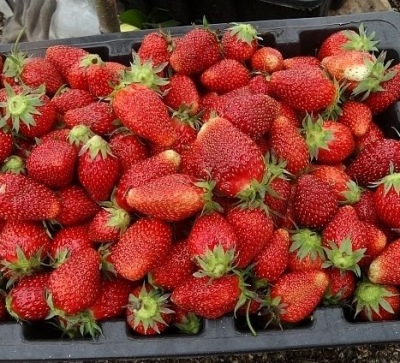
- Authors: Sverdlovsk experimental gardening station L.I. Chistyakova and I.I. Bogdanova
- Taste: sweet and sour
- Weight: up to 14.4 g
- Yield: 1 kg from 1 running meter
- Ripening terms: early
- Appointment: universal
- Description of the bush: semi-spreading, low foliage
- Berry color: light red, shiny
- Winter hardiness: winter hardy
- Height and width of the bush: height 40 cm
The Orlets strawberry variety was bred at the Sverdlovsk experimental gardening station by breeders L. I. Chistyakova and I. I. Bogdanova. It appeared as a result of crossing the Stoplight and Torpedo varieties. Among gardeners, Orlets strawberries are popular due to their excellent taste and good resistance to various diseases.
Description of the variety
Orlets strawberry has medium-sized semi-sprawling bushes up to 40 cm high. The variety is characterized by low foliage. The leaves have a rich green color, they are slightly wrinkled and slightly pubescent. Blunt teeth are located along the edges of each leaf.
Peduncles are flush with leaves. Inflorescences are multi-flowered, but compact. They have medium-sized white flowers with untwisted petals. The Orlets variety forms a few achenes, they are painted in a pale yellow color. The mustache grows in small numbers.
Ripening terms
Early flowering in April-May promotes early ripening of the berries. Fruiting usually begins at the end of June. The last berries are usually harvested in mid-July.
Yield
This variety is characterized by a high yield. It is 1 kg from 1 running meter. With industrial cultivation, these indicators reach 88 c / ha. It is imperative to harvest the strawberry Orlets together with the stalk.
Berries and their taste
The berries are light red with a glossy sheen. Their shape is not quite usual - elongated-conical with a neck. The average weight of one berry is 14.4 g. The pulp is medium-dense and juicy, colored red.
The berries are characterized by a very pleasant, sweet and sour taste. The taste qualities of this variety are highly appreciated by professionals. Strawberry Orlets is universal: it can be eaten fresh, make jam, compotes. The fruits are transportable, they tolerate transportation well.
Growing features
Despite the general unpretentiousness of the variety, you should know that it needs moderate moisture with an average watering intensity. Orlets strawberry is a winter-hardy crop and tolerates winter temperatures down to -30 degrees. However, this only happens when there is abundant snow cover. In the conditions of winters with little snow, the bushes should be mulched with straw or needles so that the plants do not freeze out.




Site selection and soil preparation
Loamy and sandy loamy soils of neutral acidity are suitable for Orlets strawberries. A month before planting, it is necessary to add a bucket of rotted manure and a glass of wood ash to the soil per 1 m2. The area for planting strawberries must be sunny and protected from the winds.
The best planting times are mid-April and late August - early September. Between young plants of the Orlets variety, it is enough to maintain a distance of 25 cm, since the bushes are very compact. Between the rows, 35-40 cm are usually left. When planting, it is very important not to deepen the root collar. At the end of planting work, the soil must be well watered and preferably mulched.

Pollination
It is important to know that Orlets strawberry belongs to self-pollinated varieties. It does not require any additional pollination.

One of the important techniques in strawberry care is feeding. Regular fertilization guarantees a rich harvest. There are several different ways to feed strawberries, and each of them is designed for a specific period of plant development. During flowering, fruiting and after it, feeding should be different.

Diseases and pests
This variety is slightly affected by powdery mildew. Strawberry Orlets has medium resistance to brown and white spots and high resistance to gray mold. Sometimes berries can be damaged by a strawberry mite.
In order to prevent these diseases, before flowering, the bushes and the soil should be treated with a 1% solution of copper sulfate. At the time of fruit setting, it is recommended to spray the plants with a pale pink solution of potassium permanganate. After picking the berries, it is necessary to process the strawberries with a 1% solution of Bordeaux liquid.

Strawberries are often subject to many dangerous diseases that can seriously undermine their condition. Among the most common are powdery mildew, gray mold, brown spot, anthracnose, and verticillosis. Before buying a variety, you need to inquire about its disease resistance.
Reproduction
Orlets can be propagated by whiskers, seeds and dividing the bush. Seed propagation is rarely used by gardeners because of its laboriousness.
For propagation by a mustache on a plant, the most powerful mustache is chosen. When roots form on the rosettes, the mustache is sprinkled with earth, while they are not cut off from the main plant. At the end of summer, the formed young plants are separated from the mother bush and planted in a designated area.
Dividing the bush is the easiest way to propagate the Orlets strawberry. To do this, you need to carefully dig out a healthy 2-3-year-old bush. The bush is divided into several parts with a sharp disinfected tool. It is important to make sure that each part has good roots. Then the strawberry bushes are planted in a permanent place and watered.



















































































